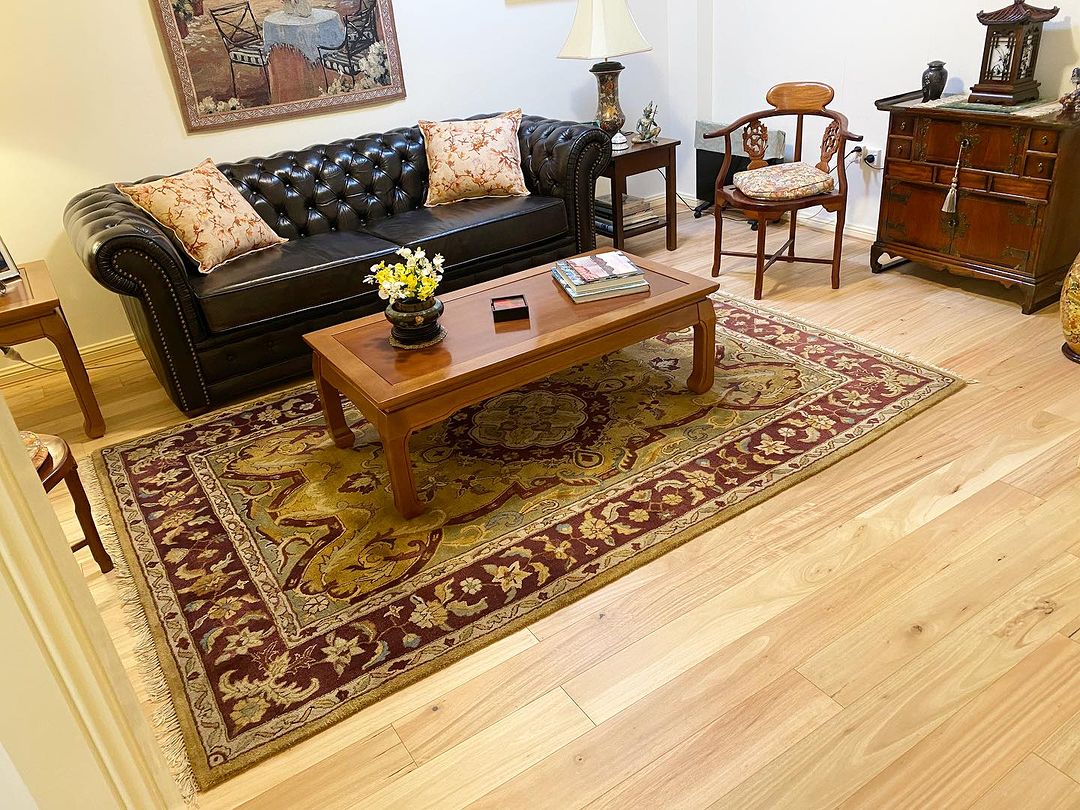

10 Sep Solid Timber Flooring Installation Guide
Welcome to our installation guide for solid timber flooring and decking products! If you’re working with Australian timber species, follow these guidelines. But always refer to the National Construction Code (NCC), Australian Standards and best practice and manufacturer guidelines. FloorVenue cannot be held responsible for any flooring installation defects as this guide serves as a general overview.
Which Solid Timber Floors Does FloorVenue Offer & Install?
At FloorVenue, we have over 25 years of experience supplying and installing hundreds of solid timber flooring options including:
- Prefinished Solid Australian Hardwoods
- Raw Solid Australian Timber
- Prefinished Solid European Oak
- Raw European Oak
- Australian Parquetry Timber
- European Oak Parquetry Timber
- Australian Timber Overlays 12 & 14mm
The exact installation method will vary depending on the type of timber floor you choose, hence we recommend engaging a professional layer where possible. This includes sanding and finishing. Their expertise will get the best result as solid timber is not a DIY friendly floor.
Moisture and Humidity
Ensure your subfloor meets the moisture and humidity levels as per AS 1684 and the NCC. This should be 5.5% moisture content or lower. This guide is informative but safety protocols and professional standards always take precedence.
Pre-Installation Preparation
Before you start, read all instructions and plan your installation. Check all materials for defects and remember timber will vary in colour and natural features so mix the boards for a balanced look across the floor. If you have any issues before or during installation stop and contact your timber supplier for advice.
Solid Australian Hardwood Flooring
This guide covers:
- 18/19mm Solid Hardwood Strip Flooring – Prefinished & Raw Timber
- Overlay Solid Hardwood Flooring
- Parquet Flooring
- Hardwood Decking
Note: Sports flooring and certain commercial applications are not included in this guide.
Where to Avoid Solid Timber
Solid timber is great for most indoor applications but not for high moisture areas like bathrooms or laundries. If you’re installing over a subfloor with radiant heating contact your manufacturer for specific instructions.
Raw Solid Hardwood Strip Flooring
This type of flooring is at least 19mm thick and is designed to be laid over plywood, battens or joists over concrete. Solid timber can be nailed to existing timber floors. Boards have tongue-and-groove on all sides to reduce waste and unnecessary cuts. For wider boards (85mm or more) follow secret nailing, and for 180mm or wider boards top nailing is required as per AS 1684.2.
Suitable Subfloors:
- Existing strip timber floors
- Particleboard, plywood or other sheet flooring
- Concrete (Requires Primer & Full Trowel)
- Joists and bearers
Prefinished Solid Hardwood Flooring
Prefinished timber is very similar to raw timber, except they can be walked on immediately after installation because they don’t require any sanding and polishing. These timber floors are sanded and sealed in factory.
Available Sizes:
- 92mm wide
- 122mm wide
- 130mm wide


Overlay Solid Hardwood Flooring
Overlay solid hardwood flooring is thinner 10mm to 14mm thick. Non-structural hardwood to be laid on solid subfloors like concrete, particleboard or plywood.
Available Sizes:
- 80mm wide
- 130mm wide
Tongue-and-groove construction makes this flooring stable.
Suitable Subfloors:
- 80x10mm or 80x13mm concrete slabs (Requires Primer & Full Trowel)
- Particleboard or plywood
- Existing strip timber floors


Parquet Flooring
Parquet flooring is made from solid hardwood blocks, usually around 260mm x 65mm x 18mm and is great for creating patterns like herringbone or chevron for a unique look. You can even use 65mm centre dots to create unique designs called basket weave.
Suitable Subfloors:
- Plywood or similar sheet flooring
- Concrete slabs (Requires Primer & Full Trowel)


Hardwood Decking
For outdoor use, hardwood decking is laid directly onto joists or structural bearers. Also suitable for gates, fencing and seating.
This product is precision milled with smooth finishes and rounded edges.
Suitable Subfloors:
- Structurally sound joists and bearers, following NCC and AS1720 guidelines
- Timber or steel posts for fencing applications
Hardwood Properties and Environmental Factors
Hardwood timber is hygroscopic, it absorbs and expels moisture depending on the environment. This natural characteristic causes expansion and contraction with changing humidity levels so it’s important to site check before installation.
Before You Install
Make sure the building is weatherproof and construction is almost complete. This will prevent damage to your new floor from heavy foot traffic. External windows, doors, cladding and stormwater systems should be finished before installation commences.
Acclimatisation of Timber
Timber will expand and contract with the environment. To minimize these movements it’s best to allow the timber to acclimatise to the site conditions. This can take up to 14 days and will ensure the timber’s moisture content matches the local humidity.
Installation Process and Key Considerations
Check the site for moisture issues like leaks or rising damp. Ensure subfloors are dry, clean and level. For concrete slabs they must be flat with a deviation of no more than 3mm over 3 meters (AS3600). Plywood and particleboard substrates must be free of contaminants and sanded.

Expansion Gaps
Timber expands and contracts with moisture so always allow for expansion gaps. Minimum gap is 12mm at all perimeter walls and around obstructions. For floors over 6 meters wide, intermediate expansion joints are required.
Acoustic Underlays
For added soundproofing products like EverQuiet or Regupol are designed to work with timber flooring and meet NCC standards for acoustic performance. Follow manufacturer’s installation instructions.
Underlay must be dual bond glued down in conjunction with the timber flooring.
By following these tips you’ll have a smooth and trouble free installation of your solid timber flooring. If in doubt contact a professional or your supplier.




























